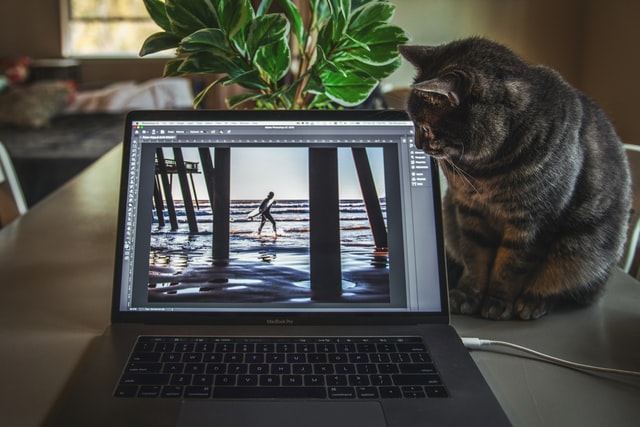No matter if you are a photographer, graphic designer or just new to the world of graphics, you will quickly realize that you need an advanced graphics processing tool like Photoshop. The beginnings are never easy, especially since the program has a lot of options. How to use Photoshop?
First look at the interface
Let’s look at the Photoshop interface first and check the location of the main areas.
- Main menu – you can find here options, filters, image settings etc.
- Options bar – this is a place where you can set detailed options for the selected tool you are currently using.
- Tools – here you can find all the tools available in Photoshop, such as a brush, pencil, selection tool, eraser, etc. If the tool has a small triangle in the bottom right corner, it means that the tool has a submenu from which you can select tools of a similar type. Click and hold the button to open it.
- Panels – internal Photoshop windows, designed for many different purposes (such as colors, layers or paths). It is useful that you can arrange the panels as you like, changing their positions, etc.

We create a new document
To open a new document, choose File -> New from the main menu. Several options will appear as follows:
- Name – the name of your file.
- Width and height – reflect the height and width of your document. You can choose between pixels, centimeters, millimeters, inches, etc. Pixel is the smallest block of information about the color of which the image is built, and this is the best option for photos displayed on a computer and for websites. Centimeters (millimeters, inches) will be most useful if you create print jobs.
- Resolution – the resolution of the document. 72ppi (pixels per inch) will be best for the network because most monitors display images at this resolution. You should probably use 300ppi for prints, making the image sharper and “denser”
Color mode – RGB and CMYK are the most commonly used.
- RGB – is built of three color channels: red, green and blue. It is mainly used to create images displayed on screens such as websites or photos that will never be printed. Unfortunately, it’s worth remembering that not all monitors display colors the same. For example, green might look different on one computer and different on another.
- CMYK – built from four color channels: cyan, magenta, yellow and black (the ink colors of most popular printers). It is mainly used for printing purposes. Unfortunately, just like with the RGB mode, printers can print colors slightly differently than we see on the monitor.
Layer
Your document (image) can be built of many different layers, for example one with the image and the other with the text. You can change their order, combine them, mix them, etc.
Coverage
The opacity parameter tells us how much layer we can see: 100% means that we can see the entire layer, but if we change the opacity to 50%, we will start to see through the layer as it becomes half transparent. 0% will make the layer disappear. Let’s see the previous example, but this time we will change the opacity of the layer with the text to 50%.








